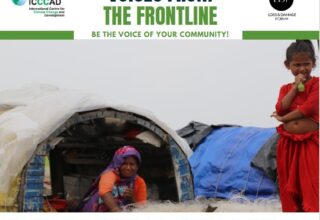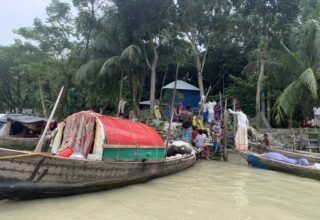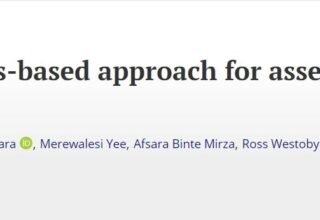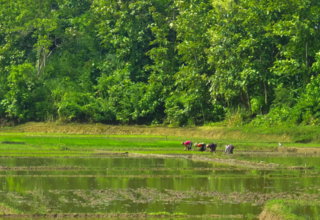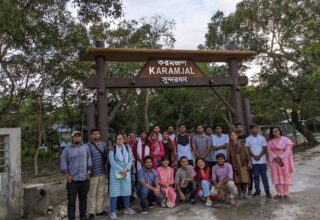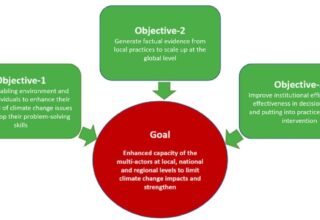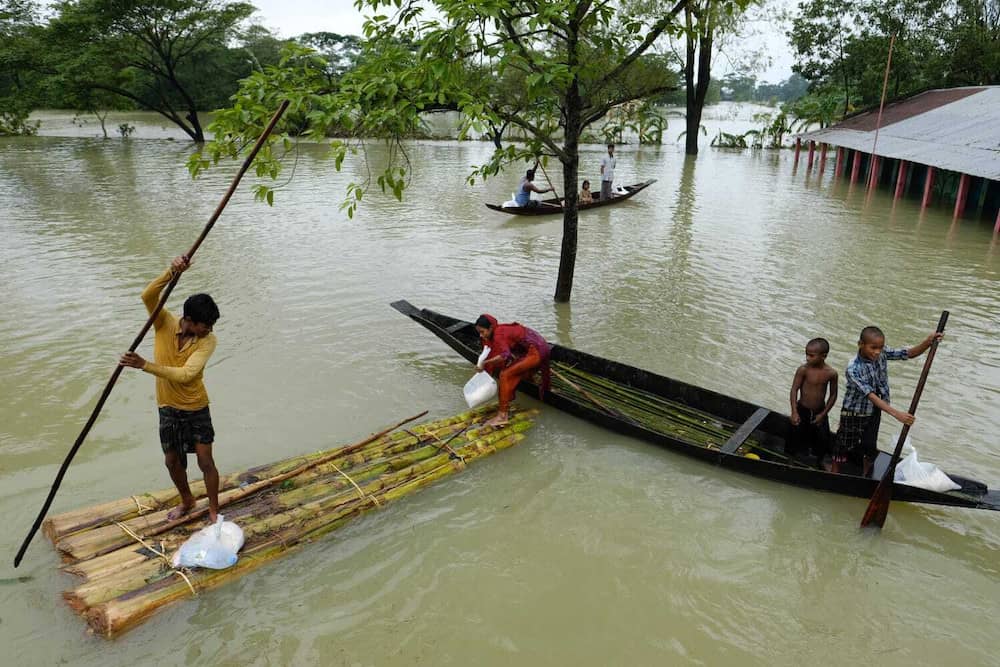
Practical Action has been working on flood risk management for many years and is interested to explore with local people what can be done to reduce the losses and damages as a result of flooding hitting the poorest, and the most vulnerable communities in Bangladesh. In 2018, we started working with the flood vulnerable communities of Faridpur in south-central Bangladesh. Faridpur district falls under the lower Ganges river floodplain and is bounded by four major rivers, the Padma, Madhumati, Arial Khan, and Kumar. Our work with the flood prone communities in the four Unions of Decree Char and North Channel under Sadar Upazila; Char Nasirpur, and Dheukhali under Sadarpur Upazila revealed that these communities are recurrently flooded during the monsoon and are exposed to high flood risk.
To support these communities and build their resilience to these frequent flood events, Practical Action is using the “Flood Resilience Measurement for Communities” (FRMC) tool, developed by “Zurich Flood Resilience Alliance” (ZFRA) to undertake holistic assessments of the resilience of these communities in real time. Based on the information collected, we then engaged in participatory action planning efforts to strengthen their resilience. From our initial data and working with these communities throughout the pandemic, it is clear that building flood resilience is about more than just protecting these communities from the flood waters. It is about reducing the risk of flood occurrence, being prepared for future floods and being able to respond to and recover from floods as quickly as possible. Increasing flood resilience therefore requires a holistic approach that improves the social, human, natural, and financial as well as physical capacities of these communities.
Based on the results of the FRMC rolled out in 8 communities, we found that the most vulnerable groups are the elderly, farmers, women, and person with disabilities. In terms of flood impacts, crop losses are the biggest losses experienced. The flood directly impacts the field, washing away young seedlings, waterlogging fields and preventing the harvest of crops. The flood waters often disrupt access to markets, preventing farmers from accessing external inputs and selling assets in markets where they can obtain better prices. One of the biggest impacts reported by many households was that they were forced to sell assets, livestock, tools, and equipment to their neighbours to survive, thus being forced to take lower prices than they could get at nearby markets. This is an erosive coping strategy, as this sale of equipment or livestock would need to be replaced and often took households at least 2-3 years to recoup their losses.
“We face loss of crops mainly during floods and if we receive early warnings of possible floods before the seasons it will be more helpful to effectively plan for the right crop for cultivation.” – Voices from Farmer group
If households could get advance warning of any upcoming flood, they could adapt their cropping systems to avoid major losses. For example, they could delay seeding if a flood were expected late in the season and instead create nursery beds on floating platforms to allow them to rapidly plant out their seedlings when the flood water recedes. But these floating beds are time consuming to produce and are an additional burden to the family, so farmers would like to know when they are needed, thus optimizing their time, energy and resources to maximize their productivity.
The flood early warning in Bangladesh is generated and provided by the Flood Forecasting and Warning Centre (FFWC), of the Bangladesh Meteorological Department (BMD) and is also shared by the Department of Disaster Management (DDM). In many instances, these warnings don’t reach the vulnerable communities living in the remotest areas. While the present cyclone Early Warning Systems (EWS) employs signal-based warning processes, there is no similar forms of mechanisms in place for floods. There is also a lack of location-specific impact-based EWS that reaches local stakeholders.
Practical Action has collaborated with FFWC in disseminating the early warning to the most vulnerable communities. During an impending disaster, we obtain information from FFWC via their website or email. We then convert the warning into a comprehensible, contextualized voice messages and disseminate it in the communities where we work. Despite the Flood Early Warning System (EWS) being an important component to reduce flood risk in Bangladesh, the EWS itself is not a holistic solution. As our study indicates, it is not adequate to just provide communities with the warning message, it is vital to also provide them with actionable information, informing them what they need to do to respond to the flood in the best way to minimize their losses and damages. In response to this, we have also installed Digital Weather Boards for early warning and weather Information at the Union Parishad’s digital centre, which is maintained by local entrepreneurs. As a result, local communities become aware of an impending flood and take precautionary measures. Additionally, our pool of trained local resilience agents assists in disseminating the warning by visiting households, sharing warning through public announcement via mic in each local area, and advising people on flood preparedness and response.
“Earlier, we were unable to prepare for floods since we rarely received flood early warnings in the Char areas. But now, the early warning message helps us immensely, as every member of my family is safe this year, despite the pandemic and flood.” – Voice from community
As a consequence of changing climate, floods are becoming more frequent, lasting longer and becoming more difficult to predict. There are limitations to what the local communities can do with only early warning information. These communities are approaching the practical limits to adaptation and for many, they are already facing the difficult choice of changing livelihoods, and for some relocating to live elsewhere. To minimize flood-related losses and damages, we must enhance the lead time and forecast accuracy. Further collaborative research, deeper scientific knowledge, and collaborative efforts from the National level stakeholders is required in this regard.
This story of loss and damage avoided by EWS is a transformational approach, with the EWS being a critical component that allows an informed response. But transformational adaptation must not be seen as a silver bullet; we must avoid the mistake of the resilience movement, a movement that offered solutions but failed to be clear on what these solutions involved, who benefited and who ended up paying for them. Transformational adaptation is about people giving something up, losing some aspect of their home, their community, their culture, or livelihood; it is imposed on them by the climate emergency and is therefore no longer a choice. Transformational adaptation must learn from the resilience backlash, it is about climate justice, it is about developed countries and polluting economies taking responsibility for their actions and using the “polluter pays principle” to compensate those who are currently paying the price for climate inaction.
Originally this article was published on August 4, 2022 at Dhaka Tribune.
Tamanna Rahman is the Project Manager for the Zurich Flood Resilience Project in Bangladesh. As part of the global alliance she is managing the planning, implementation and advocacy works in light of building resilience of the flood vulnerable communities in Bangladesh. Tamanna is interested in resilience thinking, sustainability, international and local dynamics of development interventions. Tamanna can be reached at tamanna.rahman@practicalaction.org.bd. Colin McQuistan is the Head of Climate and Resilience at Practical Action, providing technical support and oversight to development programmes in climate vulnerable developing countries, in South Asia, Latin America and Africa. Colin’s interests are in systems approaches, natural capital, sustainability and development and Colin has been following loss and damage in the climate negotiations since 2015. Colin can be reached at colin.mcquistan@practicalaction.org.uk.

